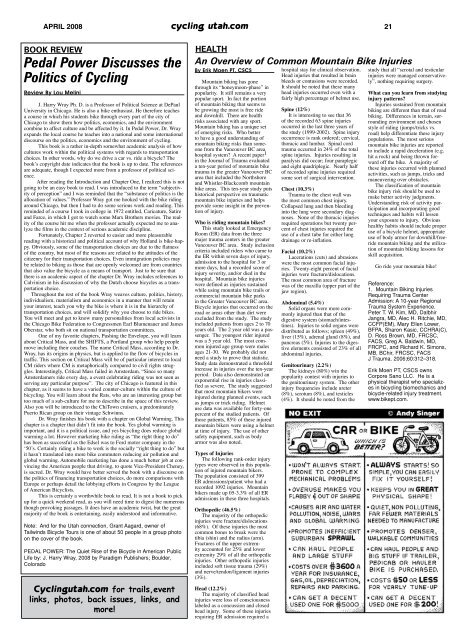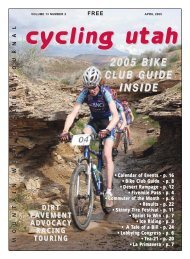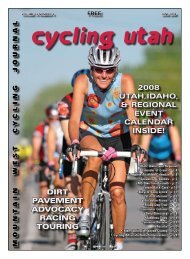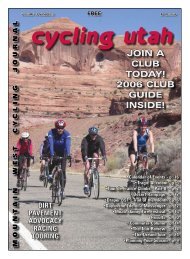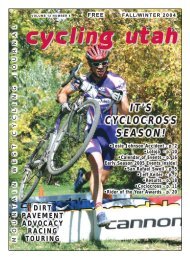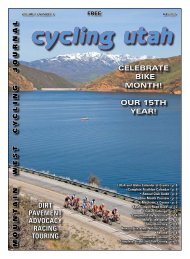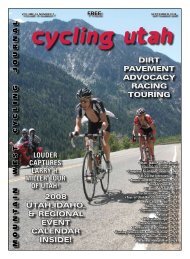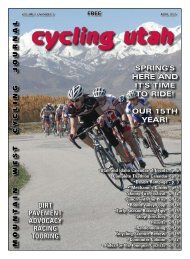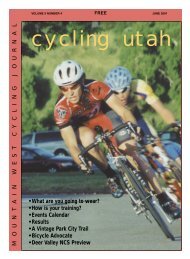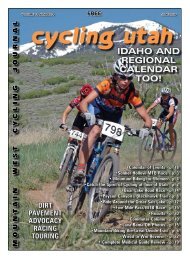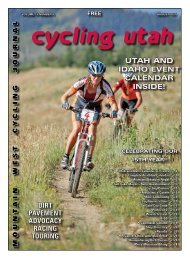April 2008 Issue - Cycling Utah
April 2008 Issue - Cycling Utah
April 2008 Issue - Cycling Utah
- No tags were found...
You also want an ePaper? Increase the reach of your titles
YUMPU automatically turns print PDFs into web optimized ePapers that Google loves.
APRIL <strong>2008</strong> cycling utah.com 21Book ReviewPedal Power Discusses thePolitics of <strong>Cycling</strong>Review By Lou MeliniJ. Harry Wray Ph. D. is a Professor of Political Science at DePaulUniversity in Chicago. He is also a bike enthusiast. He therefore teachesa course in which his students bike through every part of the city ofChicago to show them how politics, economics, and the environmentcombine to affect culture and be affected by it. In Pedal Power, Dr. Wrayexpands the local course he teaches into a national and some internationaldiscourse on the politics, economics and the environment of cycling.This book is a rather in-depth somewhat academic analysis of howcultures work within the political systems with regards to transportationchoices. In other words, why do we drive a car vs. ride a bicycle? Thebook’s copyright date indicates that the book is up to date. The referencesare adequate, though I expected more from a professor of political science.After reading the Introduction and Chapter One, I realized this is notgoing to be an easy book to read. I was introduced to the term “subjectivityof perception” and I was reminded that the “substance of politics is theallocation of values.” Professor Wray got me hooked with the bike ridingaround Chicago, but then I had to do some serious work and reading. Thisreminded of a course I took in college in 1972 entitled, Caricature, Satireand Farce, in which I got to watch some Marx Brothers movies. The realityof the course hit me when the professor actually expected me to analyzethe films in the context of serious academic discipline.Fortunately, Chapter 2 reverted to easier and more pleasurablereading with a historical and political account of why Holland is bike-happy.Obviously, some of the transportation choices are due to the flatnessof the country, but most of the reasons are related to the attitudes of thecitizenry for their transportation choices. Even immigration policies maybe related to biking as those that are openly welcomed are from countriesthat also value the bicycle as a means of transport. Just to be sure thatthere is an academic aspect of the chapter Dr. Wray includes references toCalvinism in his discussion of why the Dutch choose bicycles as a transportationchoice.Throughout the rest of the book Wray weaves culture, politics, history,individualism, materialism and economics in a manner that will retainyour interest, teach you why the bike is where it is in the hierarchy oftransportation choices, and will solidify why you choose to ride bikes.You will meet and get to know many personalities from local activists inthe Chicago Bike Federation to Congressmen Earl Blumenauer and JamesOberstar, who both sit on national transportation committees.One of my favorite chapters, Pushing the Envelope, you will learnabout Critical Mass, and the SHIFTS, a Portland group who help peoplemove including their couches. The name Critical Mass, according to Dr.Wray, has its origins in physics, but is applied to the flow of bicycles intraffic. This section on Critical Mass will be of particular interest to localCM riders where CM is metaphorically compared to civil rights struggles.Interestingly, Critical Mass failed in Amsterdam. “Since so manyAmsterdamers ride every day, a event celebrating riding was not seen asserving any particular purpose”. The city of Chicago is featured in thischapter, as it seems to have a varied counter-culture within the culture ofbicycling. You will learn about the Rats, who are an interesting group buttoo much of a sub-culture for me to describe in the space of this review.Also you will be introduced to the ChiTown cruisers, a predominatelyPuerto Rican group on their vintage Schwinns.Dr. Wray finishes his book with a chapter on Global Warming. Thischapter is a chapter that didn’t fit into the book. Yes global warming isimportant, and it is a political issue, and yes bicycling does reduce globalwarming a lot. However marketing bike riding as “the right thing to do”has been as successful as the Edsel was to Ford motor company in the‘50’s. Certainly riding a bike to work is the socially “right thing to do” butit hasn’t translated into more bike commuters reducing air pollution andglobal warming. Automobile marketing has done a much better job at convincingthe American people that driving, to quote Vice-President Cheney,is sacred. Dr. Wray would have better served the book with a discourse onthe politics of financing transportation choices, do more comparisons withEurope or perhaps detail the lobbying efforts in Congress by the Leagueof American Bicyclists.This is certainly a worthwhile book to read. It is not a book to pickup for a quick weekend read, as you will need time to digest the numerousthough provoking passages. It does have an academic twist, but the greatmajority of the book is entertaining, easily understood and informative.Note: And for the <strong>Utah</strong> connection, Grant Aagard, owner ofTailwinds Bicycle Tours is one of about 50 people in a group photoon the cover of the book.PEDAL POWER: The Quiet Rise of the Bicycle in American PublicLife by: J. Harry Wray, <strong>2008</strong> by Paradigm Publishers; Boulder,Colorado<strong>Cycling</strong>utah.com for trails,eventlinks, photos, back issues, links, andmore!HEALTHAn Overview of Common Mountain Bike InjuriesBy Erik Moen PT, CSCSMountain biking has gonethrough its “honeymoon-phase” inpopularity. It still remains a verypopular sport. In fact the portionof mountain biking that seems tobe growing the most is free rideand downhill. There are healthrisks associated with any sport.Mountain biking has a unique setof emerging risks. Who betterto have a good understanding ofmountain biking risks than someonefrom the Vancouver BC areahospital system? A recent paper 1in the Journal of Trauma evaluateda ten-year period of mountain biketrauma in the greater Vancouver BCarea that included the Northshoreand Whistler-Blackcomb mountainbike areas. This ten-year study putshistorical perspective on traumaticmountain bike injuries and helpsprovide some insight in the preventionof injury.Who is riding mountain bikes?This study looked at EmergencyRoom (ER) data from the threemajor trauma centers in the greaterVancouver BC area. Study inclusioncriteria included riders who came tothe ER within seven days of injury,admission to the hospital for 3 ormore days, had a recorded score ofinjury severity, and/or died in thehospital. Mountain bike injurieswere defined as injuries sustainedwhile using mountain bike trails orcommercial mountain bike parksin the Greater Vancouver BC area.Bicycle injuries that occurred on theroad or areas other than dirt wereexcluded from the study. The studyincluded patients from ages 2 to 70years old. The 2 year old was a passenger.The youngest rider injuredwas a 5 year old. The most commoninjured age group were malesages 21-30. We probably did notneed a study to prove that statistic.Study data demonstrated a threefoldincrease in injuries over the ten-yearperiod. Data also demonstrated anexponential rise in injuries classifiedas severe. The study suggestedthat most mountain bikers wereinjured during planned events, suchas jumps or trick riding. Helmetuse data was available for forty-onepercent of the studied patients. Ofthose patients, 85% of these injuredmountain bikers were using a helmetat time of injury. The use of othersafety equipment, such as bodyarmor was also noted.Types of InjuriesThe following rank-order injurytypes were observed in this populationof injured mountain bikers.The population consisted of 399ER admissions/patient who had arecorded 1092 injuries. Mountainbikers made up 05-3.3% of all ERadmissions in these three hospitals.Orthopedic (46.5%)The majority of the orthopedicinjuries were fracture/dislocations(68%). Of these injuries the mostcommon bones to break were thetibia (shin) and the radius (arm).Fractures of the upper extremityaccounted for 25% and lowerextremity 29% of all the orthopedicinjuries. Other orthopedic injuriesincluded soft tissue trauma (29%)and nerve/tendon/ligament injuries(3%).Head (12.2%)The majority of classified headinjuries were loss of consciousnesslabeled as a concussion and closedhead injury. Some of these injuriesrequiring ER admission required ahospital stay for clinical observation.Head injuries that resulted in brainbleeds or contusions were recorded.It should be noted that these manyhead injuries occurred even with afairly high percentage of helmet use.Spine (12%)It is interesting to see that 36of the recorded 63 spine injuriesoccurred in the last three years ofthe study (1999-2002). Spine injuryoccurrence is rank ordered; cervical,thoracic and lumbar. Spinal cordtrauma occurred in 24% of the totalspine injuries. Injuries resulting inparalysis did occur; four paraplegicand eight quadriplegic. Nearly halfof recorded spine injuries requiredsome sort of surgical intervention.Chest (10.3%)Trauma to the chest wall wasthe most common chest injury.Collapsed lung and then bleedinginto the lung were secondary diagnoses.None of the thoracic injuriesrequired operations but twenty percentof chest injuries required theuse of a chest tube for either lungdrainage or re-inflation.Facial (10.2%)Lacerations (cuts) and abrasionswere the most common facial injuries.Twenty-eight percent of facialinjuries were fracture/dislocations.The most common area of fracturewas of the maxilla (upper part of thejaw region).Abdominal (5.4%)Solid organs were more commonlyinjured than that of thedigestive system (stomach/intestines).Injuries to solid organs weredistributed as follows; spleen (49%),liver (15%), adrenal gland (8%), andpancreas (5%). Injuries to the digestiveelements consisted of 23% of allabdominal injuries.Genitourinary (2.2%)The kidneys (80%) win thepopularity contest with injuries tothe genitourinary system. The otherinjury frequencies include ureter(8%), scrotum (8%), and testicles(4%). It should be noted from thestudy that all “scrotal and testicularinjuries were managed conservatively”,nothing requiring surgery.What can you learn from studyinginjury patterns?Injuries sustained from mountainbiking are different than that of roadbiking. Differences in terrain, surroundingenvironment and chosenstyle of riding (jumps/tricks vs.road) help differentiate these injurypopulations. The most seriousmountain bike injuries are reportedto include a rapid deceleration (e.g.hit a rock) and being thrown forwardoff the bike. A majority ofthese injuries occurred with plannedactivities, such as jumps, tricks andmaneuvering over obstacles.The classification of mountainbike injury risk should be used tomake better activity judgments.Understanding risk of activity participationand incorporating goodtechniques and habits will lessenyour exposure to injury. Obvioushealthy habits should include properuse of a bicycle helmet, appropriateuse of body armor for downhill/freeridemountain biking and the utilizationof mountain biking lessons forskill acquisition.Go ride your mountain bike!Reference:1. Mountain Biking InjuriesRequiring Trauma CenterAdmission: A 10-year RegionalTrauma System Experience.Peter T. W. Kim, MD, DalbhirJangra, MD, Alec H. Ritchie, MD,CCFP(EM), Mary Ellen Lower,BFPA, Sharon Kasic, CCHRA(C),D. Ross Brown, MD, FRCSC,FACS, Greg A. Baldwin, MD,FRCPC, and Richard K. Simons,MB, BChir, FRCSC, FACSJ Trauma. 2006;60:312–318.Erik Moen PT, CSCS ownsCorpore Sano LLC. He is aphysical therapist who specializesin bicycling biomechanics andbicycle-related injury treatment.www.bikept.com.


